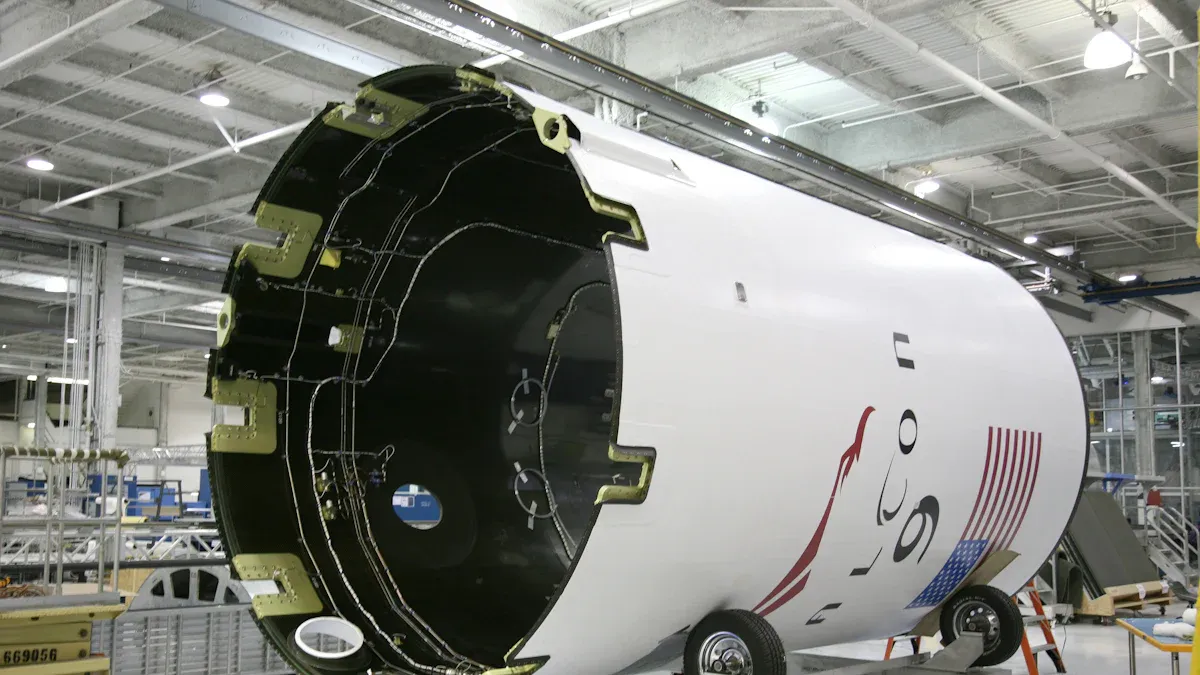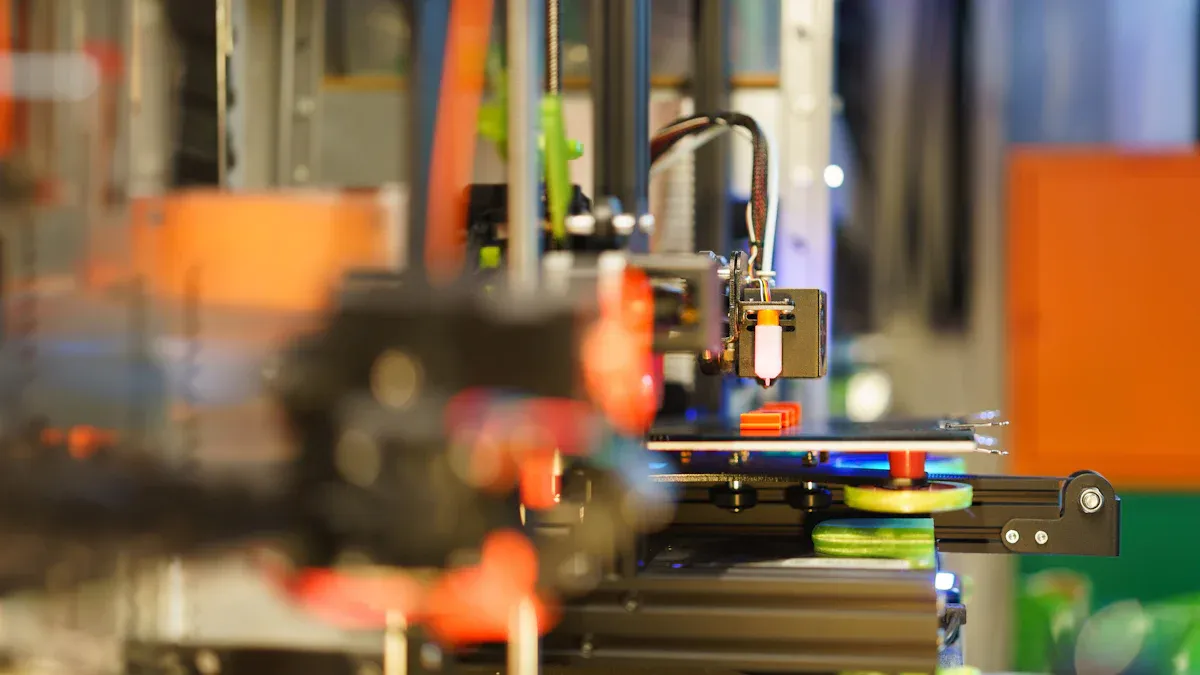
Injection molding revolutionizes aerospace manufacturing by enabling the creation of lightweight, precise components. This method improves energy efficiency by up to 84.18% and reduces production time by 29.27%. By replacing heavier materials with durable plastics, you can enhance fuel efficiency and lower costs without compromising performance or safety.

Weight reduction plays a pivotal role in improving fuel efficiency in aerospace applications. By replacing traditional metal components with lightweight plastic parts, you can significantly lower the overall weight of an aircraft. This reduction directly translates to decreased fuel consumption, reduced operational costs, and a smaller environmental footprint. For instance, Metal Injection Molding (MIM) enables the production of strong yet lightweight components using materials like titanium, which are ideal for high-performance aerospace applications.
Aitiip's collaboration with Liebherr demonstrated the potential of aerospace injection molding by achieving a 40% weight reduction in components while cutting production costs by 30%. Lighter components also increase payload capacity, allowing aircraft to carry more cargo or passengers without compromising performance. This makes injection molding an essential process for achieving weight reduction and enhancing fuel efficiency in modern aerospace manufacturing.
Precision and consistency are critical in aerospace manufacturing, where even the smallest deviation can impact safety and performance. Aerospace injection molding excels in producing components with intricate geometries and tight tolerances. Advanced technologies like Coordinate Measuring Machines (CMMs) ensure that every part meets exact specifications. These machines capture measurements down to the micrometer level, enabling manufacturers to achieve unparalleled accuracy in complex designs.
Dimensional accuracy and consistency are further enhanced through rigorous quality assurance measures. Automated inspections and comprehensive reporting ensure that each component adheres to stringent aerospace standards. This level of precision not only guarantees the reliability of lightweight plastic parts but also minimizes the risk of defects, making injection molding a cornerstone of aerospace manufacturing.
Injection molding offers a cost-effective production method for high-volume aerospace manufacturing. While the initial tooling costs may seem high, they are offset by the low cost of plastic molding, resulting in a lower cost-per-unit as production volumes increase. Economies of scale further reduce costs, making injection molding an economical choice for producing large quantities of lightweight plastic parts.
The process also supports the development of complex components in a repeatable and efficient manner. By integrating advanced technologies, aerospace injection molding minimizes material waste and optimizes production cycles. This ensures that you can achieve cost-effective production without compromising on quality or performance, making it an ideal solution for meeting the growing demand for aerospace components.
High-performance polymers are essential for creating injection molded aerospace products that meet the industry's rigorous demands. These materials offer exceptional mechanical properties, such as tensile strength and thermal stability, ensuring components can withstand extreme conditions. For example, PEEK (Polyetheretherketone) and carbon-filled PEEK provide a remarkable strength-to-weight ratio, making them ideal for structural components and engine parts. Ultem® (PEI) excels in flame resistance and dielectric properties, making it suitable for electrical connectors and enclosures.
| Polymer | Key Properties | Applications in Aerospace |
|---|---|---|
| PEEK & Carbon-Filled PEEK | Exceptional strength-to-weight ratio, high temperature resistance, chemical resistance | Structural components, engine parts, bearings |
| Ultem® (PEI) | High strength, flame resistance, excellent dielectric properties | Electrical components, connectors, enclosures |
| Torlon® (PAI) | Extreme mechanical strength, wear resistance, stability under high loads | High-friction applications like bushings and thrust washers |
| PPS | Superior dimensional stability, high temperature resistance, chemical resistance | Fuel system components, electrical insulation, structural applications |
These polymers not only enhance durability but also contribute to weight reduction, a critical factor in aerospace. By replacing traditional metals with these materials, you can achieve lightweight plastic parts that maintain structural integrity and improve fuel efficiency.
Thermoplastics play a pivotal role in manufacturing lightweight plastic parts for aerospace. These materials are noncorrosive, flame-resistant, and exhibit low water absorption, making them ideal for harsh environments. Thermoplastics like PEEK and PPS offer superior impact toughness and fire/smoke/toxicity performance, meeting stringent FST (Flame, Smoke, and Toxicity) standards required in aerospace applications.
For high-temperature applications, thermoplastics outperform traditional thermosets in cost and performance. While raw material costs for thermoplastics may be higher, the reduced assembly and processing costs make them a cost-effective choice for injection molded aerospace products. By leveraging thermoplastics, you can produce custom plastic aerospace parts that are both lightweight and durable.
Advanced composites are indispensable for aerospace applications requiring exceptional heat and chemical resistance. These materials combine high-performance resins with reinforcements like glass or carbon fibers, resulting in thermoplastic composite components with superior mechanical properties. For instance, silicone resin withstands temperatures up to 220°C and resists acids, alkalis, and organic solvents, making it ideal for extreme environments.
| Material Type | Heat Resistance (°C) | Chemical Resistance |
|---|---|---|
| Silicone Resin | Up to 220 | Resistant to acids, alkalis, organic solvents |
| Glass Epoxy (FR-4) | Not specified | Excellent chemical resistance, low moisture absorption |
| Glass Epoxy (FR-5) | Higher than FR-4 | Superior chemical resistance |
| Glass Epoxy (G-10) | Not specified | High chemical resistance |
| Glass Epoxy (G-11) | Higher than G-10 | Notable for chemical resistance |
Testing has shown that advanced composites improve performance in extreme aerospace environments. For example, the transition from the F-16 to the F-22 aircraft involved a significant increase in composite usage, resulting in higher speeds, improved damage tolerance, and enhanced survivability. By incorporating these materials into injection molding, you can produce components that excel in heat resistance, chemical stability, and mechanical strength.
Overmolding is a cutting-edge injection molding process that allows you to combine multiple materials into a single component. This technique is particularly valuable in aerospace, where lightweight manufacturing and material efficiency are critical. By bonding thermoplastics with metals or other polymers, overmolding creates parts with enhanced functionality and reduced weight. For example, a thermoplastic overmolded window cover developed through industry collaboration is 20-30% lighter and costs half as much as its metal counterpart.
The National Institute for Aviation Research (NIAR) demonstrated the efficiency of overmolding by reducing production time for a thermoplastic rib structure from 100 hours to just 2 minutes. This innovation not only supports lightweight technology but also aligns with the aerospace industry's goals for energy savings and cost reduction. Ongoing research ensures that overmolded components meet stringent certification standards, making this technique a cornerstone of modern aerospace manufacturing.
Micro-injection molding is a specialized process designed for producing intricate and miniature components with exceptional precision. In aerospace, this technique is indispensable for creating lightweight plastic parts used in sensors, connectors, and microelectronic housings. The injection molding process ensures that even the smallest parts maintain consistent quality and meet tight tolerances.
Advanced simulation and modeling tools enhance the efficiency of micro-injection molding. Digital twin technology allows you to optimize mold designs before production, reducing lead times and costs. Automation and robotics further improve consistency, enabling the production of high-performance components at scale. By leveraging micro-injection molding, you can achieve unparalleled precision in lightweight manufacturing, ensuring your aerospace components meet the highest standards.
Additive manufacturing, or 3D printing, has revolutionized prototyping in the injection molding process. By integrating this technology, you can create prototypes quickly and cost-effectively, allowing for extensive testing and design optimization before full-scale production. This approach is particularly beneficial in aerospace, where innovation and precision are paramount.
Simulation and virtual prototyping tools complement additive manufacturing by enabling you to refine designs digitally. Industry 4.0 technologies, such as IoT and smart manufacturing, further enhance this process by providing real-time data for process optimization. The combination of additive manufacturing and injection molding supports sustainability by reducing material waste and energy consumption. This integration not only accelerates development cycles but also ensures that your aerospace components are both innovative and efficient.

Lightweight plastic parts have revolutionized the design of structural components in aerospace. These materials significantly reduce aircraft weight, leading to improved fuel efficiency and lower carbon emissions. For example:
- A one-kilogram reduction in aircraft weight can save approximately 3,000 liters of fuel annually, cutting nearly 8 tons of CO2 emissions, according to IATA.
- Boeing’s 787 Dreamliner incorporates thermoplastic composite components instead of aluminum, achieving substantial weight savings.
The high strength-to-weight ratio of these materials ensures durability without compromising performance. Their corrosion resistance enhances longevity, reducing maintenance needs. Additionally, the flexibility of injection molding allows for the creation of complex aerodynamic shapes, further optimizing aircraft efficiency.
Lightweight plastic parts are ideal for interior cabin panels, offering both functionality and sustainability. A 100% recyclable thermoplastic sandwich panel, designed for aerospace interiors, exemplifies this innovation. These panels:
- Reduce weight by up to 10%, improving overall aircraft efficiency.
- Provide 30-80% higher mechanical properties and fire resistance compared to traditional materials.
- Lower production costs by 20% through a single-step manufacturing process.
Their compliance with sustainability standards and zero-waste production aligns with the industry's eco-friendly goals, making them a preferred choice for modern aircraft interiors.
Plastics excel in electrical and electronic housings due to their reliability in harsh aerospace environments. These lightweight components resist rust, corrosion, and degradation, ensuring long-term performance. Their excellent electrical insulation properties prevent short circuits and signal interference, protecting sensitive systems. High-precision plastic parts withstand extreme conditions, including high temperatures, moisture, and vibrations, making them indispensable for aerospace electronics.
Injection molding has transformed aviation and aerospace manufacturing by delivering lightweight, precise, and cost-effective solutions. Advanced materials and techniques ensure components meet rigorous industry standards. Innovations like automation and AI-driven quality control enhance efficiency and reduce defects. As aviation and aerospace technology advances, injection molding will continue driving innovation, ensuring sustainable and efficient production.
- Automation and robotics streamline production, reducing cycle times.
- Real-time monitoring and predictive maintenance improve operational efficiency.
- Industry growth, driven by increased aircraft demand, creates opportunities for innovation.
Metal injection molding combines powdered metals with binders to create intricate, lightweight components. This process ensures high precision, cost-efficiency, and durability for aerospace applications.
Injection molding enhances high-performance metal parts by ensuring consistent quality, reducing weight, and enabling complex geometries. These improvements optimize aerospace components for strength, efficiency, and reliability.
Yes, metal injection molding can replace traditional methods for many applications. It offers superior precision, reduced material waste, and cost savings, making it ideal for aerospace manufacturing.